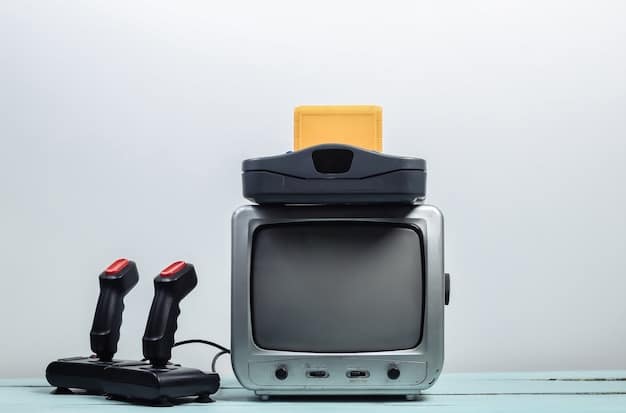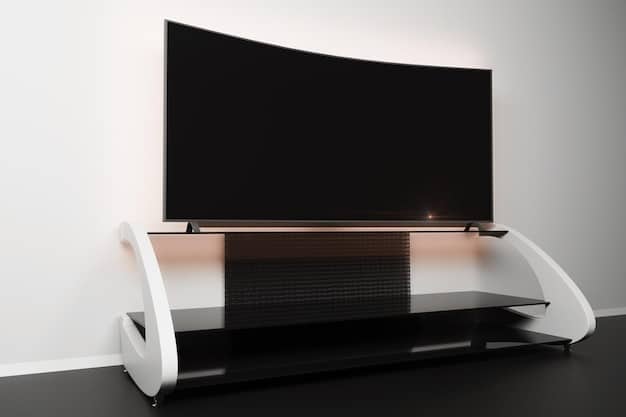The Ultimate Guide to Streaming Devices in Brazil: Choosing the Right One for Your Needs

Choosing the right streaming device in Brazil involves evaluating factors like internet connection, preferred streaming services, budget, and desired features to ensure an optimal viewing experience tailored to individual consumer needs.
Navigating the vibrant landscape of digital entertainment in Brazil can be a delightful, yet challenging, endeavor. With an increasing array of content available, understanding how to access it efficiently and affordably is paramount. This guide aims to be The Ultimate Guide to Streaming Devices in Brazil: Choosing the Right One for Your Needs.
Understanding the Brazilian Streaming Landscape
Brazil’s streaming market has seen exponential growth, driven by increasing internet penetration and a cultural shift towards on-demand content. While traditional broadcast television still holds a significant share, streaming services have emerged as powerful contenders, reshaping how Brazilians consume media. This dynamic environment offers a plethora of choices, but also presents the challenge of selecting the right device to unlock its full potential.
The evolving preferences of Brazilian consumers are a key factor. Many are cutting cords, or at least complementing their traditional TV with streaming. This trend is fueled by the flexibility, variety, and often lower cost associated with streaming platforms. Understanding these underlying currents is crucial when considering which device best suits the needs of a Brazilian household.
Content Availability and Local Preferences
When diving into the streaming landscape, it’s essential to consider what content is available and what resonates with the local audience. While global giants like Netflix, Amazon Prime Video, and Disney+ dominate, local players and specific content libraries also play a vital role.
- Global Platforms: Netflix, Amazon Prime Video, Disney+, HBO Max, and Apple TV+ are widely available, offering vast international movie and series catalogs.
- Local Offerings: Globoplay, a prominent Brazilian streaming service, provides national productions, live TV channels, and a rich archive of Globo content, making it a strong draw for many.
- Sports and Live TV: Services like DAZN, Star+, and various pay-per-view options cater to sports enthusiasts, while some platforms incorporate live broadcast channels.
- Niche Content: A growing number of niche services focus on specific genres, documentaries, or independent films, offering specialized viewing experiences.
The choice of a streaming device is often intrinsically linked to the services a user wishes to access. Compatibility with specific applications, particularly local ones, can significantly impact user satisfaction. A robust device should ideally support a wide range of services, anticipating future subscriptions and evolving content preferences.
Furthermore, local preferences extend beyond mere language. Brazilian viewers often appreciate diverse content, ranging from Hollywood blockbusters to critically acclaimed international films, and, importantly, Brazilian productions. Devices that seamlessly integrate these varied content sources tend to be more popular and valuable to the consumer.
Key Features to Consider When Choosing a Streaming Device
Selecting a streaming device is not merely about picking the cheapest or most popular option; it requires careful consideration of various features that align with individual user needs and technical setups. From display capabilities to connectivity, each element plays a role in defining the overall streaming experience.
A smart investment in a streaming device is one that not only meets current demands but also offers a degree of future-proofing. Technology evolves rapidly, and a device capable of handling higher resolutions, better audio formats, and robust connectivity will likely remain relevant for longer. It’s about striking a balance between cost, performance, and longevity.
Resolution and HDR Support
The visual quality of your streaming experience is heavily dependent on the device’s resolution and High Dynamic Range (HDR) support. With more content now available in stunning clarity, these features are becoming increasingly important.
- Standard Definition (SD) and High Definition (HD): While still common, especially for older content, HD (720p or 1080p) is now considered the minimum standard for a good viewing experience.
- 4K Ultra HD (UHD): Offers four times the pixels of 1080p, resulting in incredibly sharp and detailed images. Essential for modern TVs and premium content.
- HDR (High Dynamic Range): Enhances contrast and color accuracy, providing a more vibrant and lifelike picture. Key HDR formats include HDR10, Dolby Vision, and HLG.
Ensure your chosen device supports the highest resolution your TV can handle. If you have a 4K HDR television, a device capable of outputting 4K HDR content will allow you to maximize your display’s potential. Conversely, purchasing a high-end 4K device for an older HD TV might be an unnecessary expense.
Understanding the nuances of HDR is also important. Different streaming services may utilize different HDR formats. A device that supports multiple formats, such as HDR10 and Dolby Vision, offers greater versatility and compatibility with a wider range of content.
Connectivity and Portability
Connectivity options and portability are practical considerations that can greatly impact the convenience and versatility of your streaming device. How the device connects to your network and other peripherals matters significantly.
Most streaming devices rely on Wi-Fi for internet access. Assessing your home Wi-Fi network’s strength and positioning is crucial. Devices often support different Wi-Fi standards (e.g., Wi-Fi 5 or Wi-Fi 6), with newer standards offering faster and more stable connections. For optimal performance, especially with 4K streaming, a strong and reliable Wi-Fi signal is paramount, or even a wired Ethernet connection if available on the device.
Portability is another aspect to consider. Devices like the Fire TV Stick or Roku Streaming Stick are designed to be compact and easily transportable, ideal for use in different rooms or when traveling. Larger set-top boxes, such as Apple TV or Nvidia Shield, offer more robust features but sacrifice some portability.

User Interface and Remote Control
The user experience is heavily influenced by the device’s interface and the functionality of its remote control. A well-designed interface makes content discovery intuitive, while a good remote simplifies navigation.
- Intuitive Navigation: Look for interfaces that are clean, easy to understand, and allow quick access to your favorite apps and content.
- Customization: Some platforms allow you to customize the home screen, placing frequently used apps at the forefront.
- Voice Control: Many modern remotes include built-in microphones for voice commands, allowing users to search for content, launch apps, or control playback with spoken words.
- App Integration: A seamless integration of various streaming apps into a unified search function can greatly enhance discoverability.
The remote control’s design and features are equally important. Some remotes are minimalist, relying heavily on on-screen navigation, while others offer dedicated buttons for popular services. Features like backlighting, rechargeable batteries, and a comfortable ergonomic design contribute to a superior user experience.
Consider devices that offer universal search capabilities, allowing you to search for a movie or show across all your subscribed services simultaneously, rather than having to open each app individually. This feature can be a significant time-saver and convenience.
Top Streaming Devices Available in Brazil
Brazil’s market is rich with various streaming devices, each catering to different preferences and budgets. From dongles to set-top boxes, understanding the nuances of each popular option is crucial for making an informed decision. This section explores some of the leading contenders consumers often consider.
Chromecast with Google TV
Google’s Chromecast has evolved significantly from its original screen-casting dongle. The Chromecast with Google TV now offers a full-fledged streaming experience, complete with an intuitive interface and a dedicated remote control. It integrates seamlessly with Google’s ecosystem, making it a strong contender for those already invested in Android or Google services.
The Google TV interface aggregates content from various streaming services, offering personalized recommendations. It supports 4K HDR, including Dolby Vision and HDR10+, and also features Dolby Atmos audio passthrough. Its compact design allows it to plug directly into an HDMI port, making it highly portable and discreet.
- Pros:
- Integrated Google TV interface with personalized recommendations.
- Excellent 4K HDR and Dolby Atmos support.
- Compact and portable design.
- Seamless integration with Google Assistant and other Google devices.
- Cons:
- Relies heavily on Google services; may not appeal to those outside the ecosystem.
- Limited internal storage for apps.
- Performance can occasionally be sluggish with heavy usage.
For users who appreciate a unified content experience and benefit from Google’s extensive smart features, the Chromecast with Google TV presents a compelling option. Its ability to cast content from any device remains a strong point, complementing its new standalone streaming capabilities.
Amazon Fire TV Stick Series
Amazon’s Fire TV Stick series has gained immense popularity in Brazil due to its affordability, ease of use, and integration with the Amazon ecosystem. The line offers various models, from the entry-level Fire TV Stick Lite to the more powerful Fire TV Stick 4K Max, catering to different budgets and performance needs.
All Fire TV Stick devices run on Amazon’s Fire OS, an Android-based operating system. They come with an Alexa-enabled voice remote, allowing users to search for content, control smart home devices, and access a wide array of Alexa skills. The interface is generally user-friendly, although it tends to prioritize Amazon’s own content and services.
- Pros:
- Very affordable across its range of models.
- Integrated Alexa voice control for convenience.
- Compact and highly portable.
- Wide range of supported apps, including all major streaming services.
- Cons:
- Interface can feel biased towards Amazon content.
- Some models may not offer the highest performance for demanding tasks.
- Limited integration with non-Amazon smart home ecosystems.
The Fire TV Stick is an excellent choice for Amazon Prime subscribers and those looking for a cost-effective entry into streaming. Its “plug and play” simplicity makes it appealing to a broad audience, particularly for casual viewers or those upgrading from a smart TV’s native apps.
Roku Devices
Roku has established itself as a major player in the streaming device market, known for its extensive app ecosystem (channels, in Roku’s terminology) and user-friendly interface. Roku offers a variety of devices, including streaming sticks, set-top boxes, and even integrated Roku TVs. In Brazil, Roku Express and Roku Streaming Stick+ are popular choices.
The Roku OS is celebrated for its neutrality, not favoring any specific content provider. Its intuitive grid-based interface makes it easy to find and launch apps. Roku devices generally offer robust performance and support for various streaming formats, depending on the model.
- Pros:
- Extensive “channel” store with a vast array of streaming services.
- Neutral and highly customizable user interface.
- Affordable entry-level options.
- Reliable performance and frequent software updates.
- Cons:
- Voice search can be less comprehensive than Google Assistant or Alexa.
- Higher-end models can be relatively more expensive than basic sticks.
- Remote control might lack advanced features on cheaper models.
Roku devices are ideal for users who prioritize a wide selection of content and a straightforward, unbiased interface. Their “what to watch” feature can be very helpful for discovering new titles across multiple services, enhancing the overall viewing experience.

Apple TV 4K
For those firmly entrenched in the Apple ecosystem, the Apple TV 4K offers a premium streaming experience. While it comes at a higher price point, it delivers top-tier performance, deep integration with Apple services, and advanced features that appeal to discerning users.
The Apple TV 4K supports the highest quality formats, including 4K Dolby Vision, HDR10+, and Dolby Atmos audio. Its powerful A15 Bionic chip (in the latest models) ensures smooth navigation, fast app loading, and excellent gaming performance via Apple Arcade. The Siri Remote is elegant and functional, featuring a touch-enabled clickpad and voice control.
- Pros:
- Best-in-class performance and visual quality.
- Seamless integration with Apple services (Apple Arcade, Apple Fitness+, Apple Music, iCloud).
- Robust smart home hub capability for HomeKit devices.
- Premium build quality and user experience.
- Cons:
- Significantly higher price compared to other devices.
- Primarily caters to Apple users; less appealing for Android or Windows users.
- Limited customizability of the home screen.
The Apple TV 4K is an investment for users seeking a premium, high-performance streaming device within the Apple ecosystem. Its comprehensive features and integration make it a central hub for entertainment and smart home control.
Smart TV vs. Streaming Device: Do You Need Both?
Many modern televisions come equipped with “smart” capabilities, allowing users to access streaming apps directly. This raises a common question: if your TV is already smart, do you still need a dedicated streaming device? The answer depends largely on the age of your smart TV, its operating system, and your specific needs.
While the convenience of built-in apps is undeniable, dedicated streaming devices often offer superior performance, more frequent software updates, and a wider range of features. Understanding these differences is key to determining if an external device provides added value.
Performance and Updates
One of the primary advantages of a dedicated streaming device over a smart TV’s built-in apps is performance. Dedicated devices typically have more powerful processors and more RAM, resulting in smoother navigation, faster app loading, and less buffering. Smart TV processors, especially in older or lower-end models, can sometimes struggle with demanding apps or high-resolution content.
Software updates are another critical factor. Streaming device manufacturers, such as Roku, Google, and Amazon, frequently push out updates that introduce new features, improve performance, and enhance security. Smart TV manufacturers, conversely, might update their operating systems less frequently, particularly for older models, potentially leaving users with outdated interfaces or compatibility issues.
A dedicated device can breathe new life into an older smart TV by upgrading its smart capabilities without replacing the entire television. This can be a cost-effective way to access the latest streaming features and maintain optimal performance.
App Availability and Ecosystem Integration
While most smart TVs offer popular streaming apps like Netflix and YouTube, the breadth of app availability can vary significantly. Dedicated streaming devices often have access to a much larger app library, including niche services or local streaming platforms that might not be available on every smart TV’s operating system.
Ecosystem integration is also a major differentiator. For example, an Apple TV 4K seamlessly integrates with Apple Music, Apple Arcade, and HomeKit, offering a unified user experience for Apple users. Similarly, a Fire TV Stick provides deep integration with Alexa and Amazon Prime services. Smart TVs, while smart, might not offer the same level of deep integration with these specific ecosystems.
Consider whether your smart TV’s interface allows for easy content discovery across different apps. Dedicated devices like the Chromecast with Google TV or Roku offer universal search capabilities that can span across multiple services, simplifying the process of finding what to watch.
Tips for Optimizing Your Streaming Experience in Brazil
Acquiring the right streaming device is just one part of the equation; optimizing your overall streaming experience involves several other critical factors. From internet speed to regional content access, ensuring a smooth and enjoyable viewing session often requires attention to these details.
In a country as vast and diverse as Brazil, internet infrastructure can vary. Therefore, understanding how to maximize your connection and manage your data usage becomes particularly relevant. These tips aim to provide practical advice for Brazilians looking to get the most out of their streaming setup.
Internet Speed and Data Plans
A stable and fast internet connection is the backbone of any good streaming experience. Without adequate bandwidth, even the most powerful streaming device will struggle to deliver high-quality content without constant buffering.
- Minimum Requirements:
- SD Content: At least 3 Mbps.
- HD Content (1080p): At least 5 Mbps.
- 4K UHD Content: At least 25 Mbps, preferably higher for multiple users or simultaneous activities.
- Wired vs. Wireless: For consistent performance, especially with 4K streaming, a wired Ethernet connection is always superior. If using Wi-Fi, position your router optimally and consider a mesh Wi-Fi system for larger homes.
- Data Caps: Be mindful of your internet service provider’s data limits. Streaming 4K content consumes significantly more data than HD, potentially leading to additional charges if you exceed your plan’s allowance.
It’s advisable to perform a speed test before investing in a 4K streaming device to ensure your internet plan can support it. If your connection is consistently below the recommended speeds, upgrading your internet package should be a priority.
VPN Usage for Regional Content
While the focus of this guide is on internal content, it is worth noting that some users residing in Brazil might consider Virtual Private Networks (VPNs) to access content geo-restricted to other regions. A VPN encrypts your internet connection and routes it through a server in another country, making it appear as if you are browsing from that location.
The use of VPNs for bypassing geo-restrictions can be complex, as streaming services actively work to identify and block VPN traffic. Additionally, the legality of using VPNs to access content outside of a service’s licensed region varies and may violate terms of service.
- Considerations for VPNs:
- Legality and Terms of Service: Always check the terms of service of your streaming providers.
- Performance: VPNs can slow down your internet speed due to encryption and routing, potentially impacting streaming quality.
- Compatibility: Not all streaming devices support VPN directly. Some may require VPN setup on your router.
For most Brazilian users, focusing on the vast array of local and internationally licensed content available directly is usually the more straightforward and reliable approach. However, for specific, niche international content, a VPN might be a consideration, with the aforementioned caveats.
Audio Setup and Accessories
While visual quality is often prioritized, sound plays a crucial role in the immersive streaming experience. Investing in a good audio setup can significantly enhance your enjoyment of movies, shows, and music. Modern streaming devices support advanced audio formats, so ensure your sound system can take advantage of them.
Common advanced audio formats include Dolby Atmos and DTS:X, which create a more three-dimensional, immersive soundscape. To experience these, you’ll need compatible audio equipment, such as a soundbar with Atmos support or an A/V receiver connected to a surround sound system.
- Soundbars: A popular and often more affordable solution for upgrading TV audio without a complex multi-speaker setup.
- Home Theater Systems: For audiophiles, a full home theater setup with an A/V receiver and multiple speakers offers the ultimate audio experience.
- Bluetooth Accessories: Many streaming devices support Bluetooth, allowing you to connect wireless headphones for private listening or Bluetooth speakers for enhanced sound in smaller spaces.
Consider the placement of your sound system and how it interacts with your viewing space. Even a simple upgrade from your TV’s built-in speakers to a decent soundbar can make a remarkable difference in dialogue clarity and overall audio richness.
| Key Feature | Brief Description |
|---|---|
| 📺 4K & HDR Support | Ensures crisp visuals and vibrant colors for a modern viewing experience on compatible TVs. |
| 🚀 Performance | Determines app loading speed and overall navigation fluidity; critical for smooth streaming. |
| 🗣️ Voice Control | Convenient feature allowing content search and device control using spoken commands. |
| 🇧🇷 Local Content | Ensures compatibility with popular Brazilian streaming services like Globoplay and local channels. |
Frequently Asked Questions
▼
A streaming device is a gadget that connects to your TV to deliver content from the internet, like Netflix, Prime Video, and Globoplay. You might need one even with a smart TV because dedicated devices often offer better performance, more app options, and frequent updates, enhancing your viewing experience beyond what your smart TV’s built-in apps can provide.
▼
4K resolution is essential if you own a 4K TV and want to experience content in the highest possible quality. While not strictly necessary for everyone, a 4K device future-proofs your setup. Many popular streaming services offer 4K content, and having a compatible device ensures you can take full advantage of these offerings, providing a sharper and more detailed picture.
▼
Internet speed is crucial for a smooth streaming experience. Lower speeds can cause buffering, especially with high-resolution content like 4K. For HD streaming, at least 5 Mbps is recommended, while 4K content requires 25 Mbps or more. A stable and fast connection ensures seamless playback, higher video quality, and quicker app loading times, preventing frustrating interruptions.
▼
Yes, many modern streaming devices available in Brazil, such as the Amazon Fire TV Stick, Chromecast with Google TV, and Apple TV 4K, support voice commands. This feature allows you to search for movies, launch apps, control playback, and even integrate with smart home devices using your voice, offering a convenient and intuitive way to interact with your entertainment system.
▼
Most major streaming devices sold in Brazil, including Chromecast, Fire TV Sticks, and Roku devices, support popular local streaming services like Globoplay. The “best” choice often comes down to your preferred user interface, budget, and integration with other ecosystems (e.g., Amazon for Fire TV, Google for Chromecast). All these devices offer robust access to the variety of content available in Brazil.
Conclusion
The journey to selecting the ideal streaming device in Brazil is a multifaceted one, influenced by a blend of personal preferences, budget constraints, and technological requirements. From understanding the expansive local streaming landscape to delving into the specific features of each device, the decision making process is unique to every consumer. Whether you prioritize cutting-edge 4K visuals, an intuitive user interface, seamless ecosystem integration, or simply the most affordable entry point, the Brazilian market offers a rich tapestry of options. By carefully considering your internet connection, desired content, and existing home entertainment setup, you can make an informed choice that unlocks a world of digital entertainment, ensuring countless hours of high-quality viewing tailored precisely to your needs.





